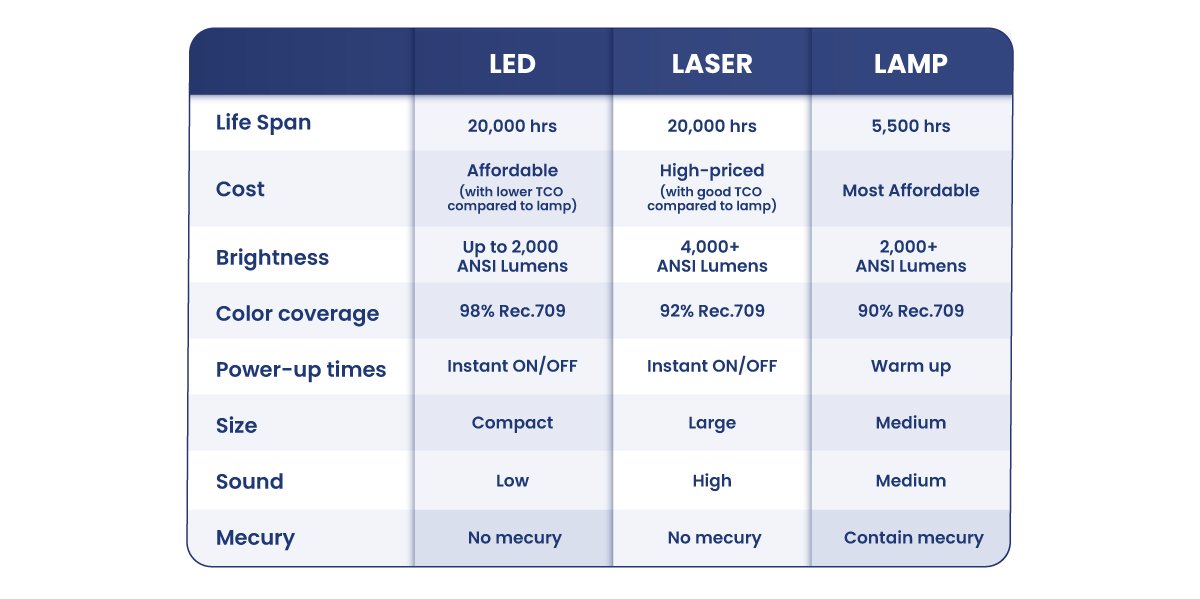Things to Consider When Choosing Between Lamp or Lamp-Free Projectors
- BenQ
- 2022-05-20

After years of living in the shadows of traditional lamp projectors due to their higher price points, the past few years have seen the emergence of lamp-free projectors as viable options for both consumers and businesses. As with most technologies on the market the use of each type of projector features tradeoffs that the buyer should consider before making the choice that best suits them. So with that in mind, this article will help introduce lamp-free projectors and discuss their pros and cons to help ensure that prospective buyers end up making the most informed decisions when selecting a projector.
What are Lamp-free Projectors?
As the name implies, lamp-free projectors (also known as Solid State Illumination or SSI projectors) are projectors that do not rely on high-pressure mercury or xenon bulbs as their light sources. Instead, their light usually comes in the form of individual LEDs or lasers for each primary color in the RGB color model, whose beams are combined to create the final projected image. This divergence in mechanics between lamp and lamp-free projectors results in the functional, economic, and environmental differences that one should note when considering the two.

The Advantages of Lamp-Free Projectors
As referenced above the main differences between lamp and lamp-free projectors break down into three large categories – functional, economic, and environmental – which we will describe below.
The Functional Advantages of Lamp-Free Projectors
The functional advantages of LED lights and lasers refer to the benefits that these types of light sources bring to the overall performance of the projector. They include the absence of stronger color performance, nearly instant power on/off, and the increased portability and noise-free operation.
●Stronger Color Performance
Similarly, because lamp-less projectors feature individual LEDs/lasers for each primary color, they are able to produce purer colors so that their overall color performance tends to outperform lamp projectors. As a result, lamp-free projectors, particularly LED projectors, feature color gamuts that can usually cover over 98% of the industry standard Rec. 709 color gamut, compared to the 90% coverage of the average lamp projector.
●Instant Power On/Off
Another upshot of the use of LEDs or lasers as light sources is the lack of warm-up or cool down periods whenever lamp-free projectors are powered on or off, which as any user knows is a noticeable issue for projectors that depend on the slower moving incandescent bulbs.
●Increased Portability and Noise-Free Operation
The final two main functional advantages of using lamp-free projectors are their added portability and noise-free operation. By bypassing a high-powered incandescent bulb, lamp-free projectors are able to save the space used by the bulb and the accommodations required for dispersing its heat, while also eliminating the noise associated with a cooling fan.
The Economic Advantages of Lamp-Free Projectors
In regards to the financial impact, choosing to use a lamp-free projector helps save money in the long run due to lower maintenance costs. This is because lamp-free projectors have longer lifespans and do not require lamp and filter replacements. So, even though lamp projectors many times are priced lower, lamp-free projectors usually end up having a lower total cost of ownership (TCO).
The Environmental Advantages of Lamp-Free Projectors
As most users of regular light bulbs know, incandescent bulbs consume a lot more energy than LED lights and lasers. The same runs true when comparing the projectors that rely on these different light sources. Thus, lamp-free projectors are considered to be more energy efficient and less wasteful (since there isn’t the additional waste due to part replacements), which are important benefits to the environmentally-minded.
Deciding Between an LED and Laser Projector
Given all the advantages that lamp-free projectors in general bring, what should a prospective buyer keep in mind when deciding between the two types of lamp-free projectors? In other words, what are the main differences between LED and laser projectors? The main differences broadly fall under two main categories: brightness and cost. LED lights are diodes that give off cold light, as such the projectors that rely on them as their light sources have the drawback that they produce images with lower overall brightness when compared to other types of projectors. This, though, is not a major obstacle if the projector is meant for use in smaller spaces, which makes LEDs the most suitable light sources for portable or pico projectors. The mechanics that produce the light for laser projectors on the other hand do not feature such brightness limitations, though the tradeoff is that for the time being these projectors are costlier than both LED projectors and lamp-based projectors. These considerations make laser projectors more suitable for use within larger spaces that require brighter images, such as large-scale conference rooms, auditoriums, and other public spaces. One should keep in mind though that as time goes by and the use of laser projectors becomes more prevalent, the costs associated with their use will gradually decline.
Exploring BenQ’s Lines of Lamp and Lamp-Free Projectors
Regardless of what type of light source you decide upon for your projector, BenQ has got you covered with lamp and lamp-free – including LED and Laser – projectors that suit any type of scenario you might consider, from your average meeting room to large scale conference rooms and beyond.
Learn more about our new LED projectors in our Meeting Room Projectors page.
Recommended Articles
-
Trends & Knowledge
Why ANSI Lumens Shouldn’t be the Last Word for Projector Brightness
This article gives you information about what is perceived brightness and when is the Helmholtz–Kohlrausch Effect not as effective
2022.05.05 -
Trends & Knowledge
Understanding the Difference Between ANSI and LED Lumens
This article provides you understanding of what a “lumen” is and the difference between the various lumens units, such as ANSI and LED Lumens.
2022.05.05 -
Trends & Knowledge
What is a Laser Projector?
2020.04.18 -
Trends & Knowledge
The Three Reasons You Need a Laser Projector in Your Conference Room
If you’re in the market for a first projector or replacing old office projectors, you know it’s easy to get lost in the oceans of arcane technical specs. To simplify your decision, we’d like to tell you the 3 reasons you should choose laser projectors
2019.05.07